[English] 日本語
 Yorodumi
Yorodumi- PDB-2ao6: Crystal structure of the human androgen receptor ligand binding d... -
+ Open data
Open data
- Basic information
Basic information
| Entry | Database: PDB / ID: 2ao6 | |||||||||
|---|---|---|---|---|---|---|---|---|---|---|
| Title | Crystal structure of the human androgen receptor ligand binding domain bound with TIF2(iii) 740-753 peptide and R1881 | |||||||||
 Components Components |
| |||||||||
 Keywords Keywords | TRANSCRIPTION / CRYSTAL STRUCTURE / HUMAN ANDROGEN RECEPTOR LIGAND BINDING DOMAIN / TRANSCRIPTIONAL INTERMEDIARY FACTOR 2 740-753 / R188 | |||||||||
| Function / homology |  Function and homology information Function and homology informationmale somatic sex determination / prostate induction / lateral sprouting involved in mammary gland duct morphogenesis / male genitalia morphogenesis / regulation of developmental growth / POU domain binding / positive regulation of integrin biosynthetic process / tertiary branching involved in mammary gland duct morphogenesis / animal organ formation / androgen binding ...male somatic sex determination / prostate induction / lateral sprouting involved in mammary gland duct morphogenesis / male genitalia morphogenesis / regulation of developmental growth / POU domain binding / positive regulation of integrin biosynthetic process / tertiary branching involved in mammary gland duct morphogenesis / animal organ formation / androgen binding / cellular response to testosterone stimulus / regulation of systemic arterial blood pressure / Leydig cell differentiation / epithelial cell differentiation involved in prostate gland development / positive regulation of epithelial cell proliferation involved in prostate gland development / prostate gland epithelium morphogenesis / prostate gland growth / epithelial cell morphogenesis / membraneless organelle assembly / RNA polymerase II general transcription initiation factor binding / positive regulation of insulin-like growth factor receptor signaling pathway / positive regulation of transcription by RNA polymerase III / RNA polymerase II intronic transcription regulatory region sequence-specific DNA binding / morphogenesis of an epithelial fold / cellular response to steroid hormone stimulus / positive regulation of intracellular estrogen receptor signaling pathway / androgen receptor signaling pathway / seminiferous tubule development / RUNX2 regulates osteoblast differentiation / locomotor rhythm / aryl hydrocarbon receptor binding / nuclear steroid receptor activity / cellular response to Thyroglobulin triiodothyronine / regulation of glucose metabolic process / Synthesis of bile acids and bile salts / regulation of lipid metabolic process / mammary gland alveolus development / cellular response to estrogen stimulus / estrogen response element binding / Synthesis of bile acids and bile salts via 27-hydroxycholesterol / Endogenous sterols / Synthesis of bile acids and bile salts via 7alpha-hydroxycholesterol / nuclear receptor-mediated steroid hormone signaling pathway / single fertilization / RNA polymerase II core promoter sequence-specific DNA binding / regulation of protein localization to plasma membrane / Recycling of bile acids and salts / transcription regulator inhibitor activity / cellular response to hormone stimulus / intracellular receptor signaling pathway / estrogen receptor signaling pathway / steroid binding / : / positive regulation of adipose tissue development / Regulation of lipid metabolism by PPARalpha / peroxisome proliferator activated receptor signaling pathway / regulation of cellular response to insulin stimulus / BMAL1:CLOCK,NPAS2 activates circadian expression / insulin-like growth factor receptor signaling pathway / SUMOylation of transcription cofactors / response to progesterone / Activation of gene expression by SREBF (SREBP) / HSP90 chaperone cycle for steroid hormone receptors (SHR) in the presence of ligand / epithelial cell proliferation / nuclear receptor binding / negative regulation of extrinsic apoptotic signaling pathway / negative regulation of smoothened signaling pathway / RNA polymerase II transcription regulatory region sequence-specific DNA binding / positive regulation of cell differentiation / SUMOylation of intracellular receptors / circadian regulation of gene expression / molecular condensate scaffold activity / mRNA transcription by RNA polymerase II / Heme signaling / Transcriptional activation of mitochondrial biogenesis / PPARA activates gene expression / Activated PKN1 stimulates transcription of AR (androgen receptor) regulated genes KLK2 and KLK3 / Cytoprotection by HMOX1 / beta-catenin binding / Nuclear Receptor transcription pathway / Transcriptional regulation of white adipocyte differentiation / positive regulation of miRNA transcription / RNA polymerase II transcription regulator complex / transcription coactivator binding / male gonad development / multicellular organism growth / nuclear receptor activity / negative regulation of epithelial cell proliferation / : / cell-cell signaling / MAPK cascade / HATs acetylate histones / MLL4 and MLL3 complexes regulate expression of PPARG target genes in adipogenesis and hepatic steatosis / ATPase binding / DNA-binding transcription activator activity, RNA polymerase II-specific / spermatogenesis / transcription regulator complex / Estrogen-dependent gene expression / in utero embryonic development / molecular adaptor activity Similarity search - Function | |||||||||
| Biological species |  Homo sapiens (human) Homo sapiens (human) | |||||||||
| Method |  X-RAY DIFFRACTION / X-RAY DIFFRACTION /  SYNCHROTRON / SYNCHROTRON /  MOLECULAR REPLACEMENT / Resolution: 1.89 Å MOLECULAR REPLACEMENT / Resolution: 1.89 Å | |||||||||
 Authors Authors | He, B. / Gampe Jr., R.T. / Kole, A.J. / Hnat, A.T. / Stanley, T.B. / An, G. / Stewart, E.L. / Kalman, R.I. / Minges, J.T. / Wilson, E.M. | |||||||||
 Citation Citation |  Journal: Mol.Cell / Year: 2004 Journal: Mol.Cell / Year: 2004Title: Structural basis for androgen receptor interdomain and coactivator interactions suggests a transition in nuclear receptor activation function dominance Authors: He, B. / Gampe Jr., R.T. / Kole, A.J. / Hnat, A.T. / Stanley, T.B. / An, G. / Stewart, E.L. / Kalman, R.I. / Minges, J.T. / Wilson, E.M. | |||||||||
| History |
|
- Structure visualization
Structure visualization
| Structure viewer | Molecule:  Molmil Molmil Jmol/JSmol Jmol/JSmol |
|---|
- Downloads & links
Downloads & links
- Download
Download
| PDBx/mmCIF format |  2ao6.cif.gz 2ao6.cif.gz | 68.7 KB | Display |  PDBx/mmCIF format PDBx/mmCIF format |
|---|---|---|---|---|
| PDB format |  pdb2ao6.ent.gz pdb2ao6.ent.gz | 48.9 KB | Display |  PDB format PDB format |
| PDBx/mmJSON format |  2ao6.json.gz 2ao6.json.gz | Tree view |  PDBx/mmJSON format PDBx/mmJSON format | |
| Others |  Other downloads Other downloads |
-Validation report
| Summary document |  2ao6_validation.pdf.gz 2ao6_validation.pdf.gz | 698.2 KB | Display |  wwPDB validaton report wwPDB validaton report |
|---|---|---|---|---|
| Full document |  2ao6_full_validation.pdf.gz 2ao6_full_validation.pdf.gz | 700.8 KB | Display | |
| Data in XML |  2ao6_validation.xml.gz 2ao6_validation.xml.gz | 13.1 KB | Display | |
| Data in CIF |  2ao6_validation.cif.gz 2ao6_validation.cif.gz | 18.2 KB | Display | |
| Arichive directory |  https://data.pdbj.org/pub/pdb/validation_reports/ao/2ao6 https://data.pdbj.org/pub/pdb/validation_reports/ao/2ao6 ftp://data.pdbj.org/pub/pdb/validation_reports/ao/2ao6 ftp://data.pdbj.org/pub/pdb/validation_reports/ao/2ao6 | HTTPS FTP |
-Related structure data
| Related structure data |  1xowSC  1xq3C S: Starting model for refinement C: citing same article ( |
|---|---|
| Similar structure data |
- Links
Links
- Assembly
Assembly
| Deposited unit | 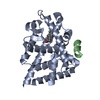
| ||||||||||
|---|---|---|---|---|---|---|---|---|---|---|---|
| 1 |
| ||||||||||
| Unit cell |
|
- Components
Components
| #1: Protein | Mass: 29046.074 Da / Num. of mol.: 1 / Fragment: LIGAND BINDING DOMAIN Source method: isolated from a genetically manipulated source Details: INHIBITED BY R1881 / Source: (gene. exp.)  Homo sapiens (human) Homo sapiens (human)Description: human AR LBD (663-919) with thrombin cleavable NH2-terminal HIS tag Gene: Ar, Nr3c4 / Plasmid: pET15b / Species (production host): Escherichia coli / Production host:  |
|---|---|
| #2: Protein/peptide | Mass: 2810.212 Da / Num. of mol.: 1 / Fragment: BOX 3, RESIDUES 740-753 / Source method: obtained synthetically Details: 14-MER FRAGMENT OF TRANSCRIPTIONAL INTERMEDIARY FACTOR 2, RESIDUES 740-753 References: UniProt: Q15596 |
| #3: Chemical | ChemComp-R18 / ( |
| #4: Water | ChemComp-HOH / |
-Experimental details
-Experiment
| Experiment | Method:  X-RAY DIFFRACTION / Number of used crystals: 1 X-RAY DIFFRACTION / Number of used crystals: 1 |
|---|
- Sample preparation
Sample preparation
| Crystal | Density Matthews: 2.02 Å3/Da / Density % sol: 40 % |
|---|---|
| Crystal grow | Temperature: 293 K / Method: vapor diffusion, hanging drop / pH: 7.9 Details: 100mM BTP, 0.6 M Na/K Tartrate, pH 7.90, VAPOR DIFFUSION, HANGING DROP, temperature 293K |
-Data collection
| Diffraction | Mean temperature: 93 K |
|---|---|
| Diffraction source | Source:  SYNCHROTRON / Site: SYNCHROTRON / Site:  APS APS  / Beamline: 32-ID / Wavelength: 1 / Beamline: 32-ID / Wavelength: 1 |
| Detector | Type: MARRESEARCH / Detector: CCD / Date: Apr 10, 2004 |
| Radiation | Protocol: SINGLE WAVELENGTH / Monochromatic (M) / Laue (L): M / Scattering type: x-ray |
| Radiation wavelength | Wavelength: 1 Å / Relative weight: 1 |
| Reflection | Resolution: 1.89→50 Å / Num. obs: 20036 / % possible obs: 93 % / Observed criterion σ(I): 0 / Redundancy: 6.3 % / Biso Wilson estimate: 22.3 Å2 / Rmerge(I) obs: 0.073 / Net I/σ(I): 30 |
| Reflection shell | Resolution: 1.89→1.94 Å / Redundancy: 3.9 % / Rmerge(I) obs: 0.227 / Mean I/σ(I) obs: 4.7 / % possible all: 60.9 |
- Processing
Processing
| Software |
| ||||||||||||||||||||||||||||||||||||
|---|---|---|---|---|---|---|---|---|---|---|---|---|---|---|---|---|---|---|---|---|---|---|---|---|---|---|---|---|---|---|---|---|---|---|---|---|---|
| Refinement | Method to determine structure:  MOLECULAR REPLACEMENT MOLECULAR REPLACEMENTStarting model: 1XOW Resolution: 1.89→50 Å / Rfactor Rfree error: 0.01 / Data cutoff high absF: 850450.64 / Data cutoff low absF: 0 / Isotropic thermal model: RESTRAINED / Cross valid method: THROUGHOUT / σ(F): 0 Details: Gros, Grosse-Kunstleve, Jiang, Kuszewski, Nilges, Pannu, Read, Rice, Simonson, Warren and Molecular Simulations Inc., (Badger, Berard, Kumar, Szalma, Yip).
| ||||||||||||||||||||||||||||||||||||
| Solvent computation | Solvent model: FLAT MODEL / Bsol: 57.0418 Å2 / ksol: 0.368009 e/Å3 | ||||||||||||||||||||||||||||||||||||
| Displacement parameters | Biso mean: 28.7 Å2
| ||||||||||||||||||||||||||||||||||||
| Refine analyze |
| ||||||||||||||||||||||||||||||||||||
| Refinement step | Cycle: LAST / Resolution: 1.89→50 Å
| ||||||||||||||||||||||||||||||||||||
| Refine LS restraints |
| ||||||||||||||||||||||||||||||||||||
| LS refinement shell | Resolution: 1.89→1.99 Å / Rfactor Rfree error: 0.042 / Total num. of bins used: 6
| ||||||||||||||||||||||||||||||||||||
| Xplor file |
|
 Movie
Movie Controller
Controller




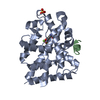
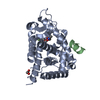
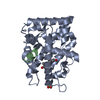
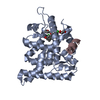
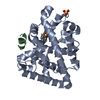

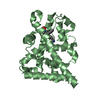

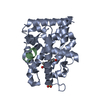
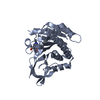


 PDBj
PDBj















